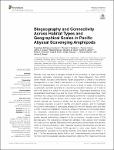Biogeography and Connectivity Across Habitat Types and Geographical Scales in Pacific Abyssal Scavenging Amphipods
| dc.contributor.author | Bribiesca-Contreras, G | |
| dc.contributor.author | Dahlgren, TG | |
| dc.contributor.author | Horton, T | |
| dc.contributor.author | Drazen, JC | |
| dc.contributor.author | Drennan, R | |
| dc.contributor.author | Jones, DOB | |
| dc.contributor.author | Leitner, AB | |
| dc.contributor.author | McQuaid, KA | |
| dc.contributor.author | Smith, CR | |
| dc.contributor.author | Taboada, S | |
| dc.contributor.author | Wiklund, H | |
| dc.contributor.author | Glover, AG | |
| dc.date.accessioned | 2023-10-16T16:06:49Z | |
| dc.date.available | 2023-10-16T16:06:49Z | |
| dc.date.issued | 2021-07-27 | |
| dc.identifier.issn | 2296-7745 | |
| dc.identifier.issn | 2296-7745 | |
| dc.identifier.other | ARTN 705237 | |
| dc.identifier.uri | https://pearl.plymouth.ac.uk/handle/10026.1/21445 | |
| dc.description.abstract |
Recently, there has been a resurgent interest in the exploration of deep-sea mineral deposits, particularly polymetallic nodules in the Clarion-Clipperton Zone (CCZ), central Pacific. Accurate environmental impact assessment is critical to the effective management of a new industry and depends on a sound understanding of species taxonomy, biogeography, and connectivity across a range of scales. Connectivity is a particularly important parameter in determining ecosystem resilience, as it helps to define the ability of a system to recover post-impact. Scavenging amphipods in the superfamilies Alicelloidea Lowry and De Broyer, 2008 and Lysianassoidea Dana, 1849 contribute to a unique and abundant scavenging community in abyssal ecosystems. They are relatively easy to sample and in recent years have become the target of several molecular and taxonomic studies, but are poorly studied in the CCZ. Here, a molecular approach is used to identify and delimit species, and to investigate evolutionary relationships of scavenging amphipods from both abyssal plain and deep (&gt;3000 m) seamount habitats in three APEIs (Areas of Particular Environmental Interest, i.e., designated conservation areas) in the western CCZ. A total of 17 different morphospecies of scavenging amphipods were identified, which include at least 30 genetic species delimited by a fragment of the cytochrome <jats:italic>c</jats:italic> oxidase subunit I (COI) barcode gene. The scavenging communities sampled in the western CCZ included the most common species (<jats:italic>Abyssorchomene gerulicorbis</jats:italic> (Shulenberger and Barnard, 1976), <jats:italic>A. chevreuxi</jats:italic> (Stebbing, 1906), <jats:italic>Paralicella caperesca</jats:italic> Shulenberger and Barnard, 1976, and <jats:italic>P. tenuipes</jats:italic> Chevreux, 1908) reported for other ocean basins. Only four morphospecies, representing five genetic species, were shared between APEIs 1, 4, and 7. The two abyssal plain sites at APEIs 4 and 7 were dominated by two and three of the most common scavenging species, respectively, while the APEI 1 seamount site was dominated by two species potentially new to science that appeared to be endemic to the site. The presence of common species in all sites and high genetic diversity, yet little geographic structuring, indicate connectivity over evolutionary time scales between the areas, which span about 1500 km. Similar to recent studies, the differences in amphipod assemblages found between the seamount and abyssal sites suggest that ecological conditions on seamounts generate distinct community compositions. | |
| dc.format.extent | 705237- | |
| dc.publisher | Frontiers Media SA | |
| dc.subject | scavenging amphipods | |
| dc.subject | connectivity | |
| dc.subject | biodiversity | |
| dc.subject | Clarion-Clipperton Zone | |
| dc.subject | deep-sea mining | |
| dc.subject | seamount | |
| dc.title | Biogeography and Connectivity Across Habitat Types and Geographical Scales in Pacific Abyssal Scavenging Amphipods | |
| dc.type | journal-article | |
| dc.type | Article | |
| plymouth.author-url | https://www.webofscience.com/api/gateway?GWVersion=2&SrcApp=PARTNER_APP&SrcAuth=LinksAMR&KeyUT=WOS:000679416000001&DestLinkType=FullRecord&DestApp=ALL_WOS&UsrCustomerID=11bb513d99f797142bcfeffcc58ea008 | |
| plymouth.volume | 8 | |
| plymouth.publisher-url | http://dx.doi.org/10.3389/fmars.2021.705237 | |
| plymouth.publication-status | Published online | |
| plymouth.journal | Frontiers in Marine Science | |
| dc.identifier.doi | 10.3389/fmars.2021.705237 | |
| plymouth.organisational-group | |Plymouth | |
| plymouth.organisational-group | |Plymouth|Faculty of Science and Engineering | |
| plymouth.organisational-group | |Plymouth|Faculty of Science and Engineering|School of Biological and Marine Sciences | |
| plymouth.organisational-group | |Plymouth|Users by role | |
| plymouth.organisational-group | |Plymouth|Users by role|Academics | |
| dcterms.dateAccepted | 2021-07-07 | |
| dc.date.updated | 2023-10-16T16:06:48Z | |
| dc.rights.embargodate | 2023-10-17 | |
| dc.identifier.eissn | 2296-7745 | |
| rioxxterms.versionofrecord | 10.3389/fmars.2021.705237 |


